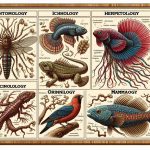Exploring Ornithology: The Fascinating World of Birds
Ornithology, the scientific study of birds, offers a window into a diverse and captivating realm that spans continents, ecosystems, and evolutionary history. It encompasses a broad spectrum of disciplines, from anatomy and physiology to behavior, ecology, and conservation.
Avian Diversity and Adaptations
Avian diversity is a testament to the evolutionary success of birds, with over 10,000 recognized species inhabiting nearly every ecosystem on Earth. From the towering eagles of the sky to the tiny hummingbirds that hover among flowers, birds display a remarkable array of adaptations that allow them to thrive in diverse habitats.
Adaptations for Feeding
Birds exhibit specialized adaptations in their beaks, bills, and feet to exploit various food sources. For example, the long, probing beaks of ibises are ideal for probing mudflats for invertebrates, while the hooked beaks of raptors such as eagles and hawks are adapted for tearing flesh.
Adaptations for Flight
Flight is a defining characteristic of birds, facilitated by lightweight bones, powerful breast muscles, and feathers adapted for aerodynamic efficiency. Birds like hummingbirds have evolved unique wing shapes and rapid wing beats that allow them to hover and maneuver with precision, while albatrosses have long, narrow wings ideal for gliding effortlessly over oceans.
Adaptations for Camouflage and Display
Birds employ intricate plumage patterns and colors for camouflage, mating displays, and signaling. Species like the peafowl boast elaborate feather patterns used in courtship displays, while others, like the snowy owl, blend seamlessly with their snowy surroundings to evade predators.
Adaptations for Thermal Regulation
Birds have evolved various mechanisms to regulate body temperature across diverse climates. In cold environments, species like the penguin have dense, insulating plumage and layers of fat to conserve heat. Conversely, desert-adapted birds such as roadrunners have reduced feather coverage and efficient evaporative cooling mechanisms to cope with extreme heat.
The study of avian diversity and adaptations not only enriches our understanding of evolutionary biology but also underscores the importance of birds as ecological keystones. Ornithologists continue to unravel the intricacies of these adaptations, shedding light on how birds persist and thrive in changing environments.
For more information on avian diversity and adaptations, explore resources from organizations such as the American Ornithological Society and BirdLife International.

Behavioral Ecology and Social Dynamics
The study of bird behavior provides insights into complex social interactions, mating strategies, and cooperative behaviors. Birds exhibit a rich repertoire of behaviors, from intricate courtship displays and territorial defense to cooperative breeding and altruistic behaviors. Ornithologists investigate how these behaviors evolve and contribute to reproductive success, social structure, and species survival.
Migration and Navigation
Bird migration is one of the most awe-inspiring phenomena in the animal kingdom. Many species undertake epic journeys spanning thousands of miles between breeding and wintering grounds, driven by seasonal changes in food availability and environmental conditions. Migration routes and navigation mechanisms, including celestial cues, geomagnetic fields, and environmental landmarks, remain subjects of intensive study, revealing the remarkable adaptability and endurance of migratory birds.
Ecological Roles and Ecosystem Services
Birds play crucial roles in ecosystem dynamics and provide essential ecosystem services. As predators, prey, seed dispersers, pollinators, and scavengers, they influence vegetation structure, nutrient cycling, and pest control. For example, hummingbirds and bats pollinate flowers, while raptors help regulate rodent populations. Ornithologists study these ecological interactions to understand the cascading effects of bird populations on biodiversity and ecosystem stability.
Conservation Challenges and Global Efforts
Despite their ecological significance, birds face numerous conservation challenges, primarily driven by human activities. Habitat loss, fragmentation, climate change, pollution, and illegal wildlife trade threaten bird populations worldwide. Conservation efforts aim to protect critical habitats, restore degraded ecosystems, implement sustainable land use practices, and mitigate anthropogenic impacts. Citizen science initiatives, public education campaigns, and policy advocacy are integral to promoting bird conservation and fostering global awareness of their plight.
Advancing Knowledge and Inspiring Action
Ornithology advances scientific knowledge through innovative research techniques, technological advancements, and interdisciplinary collaborations. Remote sensing, genetic analysis, and bioacoustics provide new insights into bird behavior, population dynamics, and ecosystem health. Beyond academia, ornithology inspires a global community of bird enthusiasts, citizen scientists, educators, and conservationists dedicated to understanding, appreciating, and safeguarding avian biodiversity.
By unraveling the mysteries of bird biology and advocating for their conservation, ornithologists contribute to preserving Earth’s natural heritage and ensuring a sustainable future for birds and humans alike. Continued research, education, and collective action are essential to addressing conservation challenges and protecting the invaluable services that birds provide to ecosystems and society.
For more information on exploring ornithology and opportunities for involvement, visit organizations such as the American Ornithological Society and BirdLife International.

Importance of Ornithology
Ornithology, the scientific study of birds, plays a pivotal role in our understanding of avian biology, ecology, behavior, and conservation. Its importance extends across various domains:
1. Biodiversity and Ecosystem Health
Birds are integral components of ecosystems worldwide, contributing to biodiversity and ecological balance. Ornithological research helps identify species richness, population trends, and interactions within food webs, indicating ecosystem health and resilience.
2. Indicator Species for Environmental Change
Birds are sensitive to environmental changes such as habitat loss, climate variability, pollution, and invasive species. Monitoring bird populations provides early warnings of ecosystem disturbances, helping to assess the impacts of human activities and climate change on natural habitats.
3. Conservation and Habitat Management
Ornithology informs conservation strategies by identifying critical habitats, migratory routes, and breeding sites essential for bird survival. Conservation efforts, including habitat restoration, protected area designation, and species recovery plans, rely on ornithological data to prioritize actions and mitigate threats to vulnerable bird populations.
4. Economic and Cultural Significance
Birds contribute to local economies through ecotourism, birdwatching activities, and agricultural pest control services. Ornithological studies quantify these economic benefits and foster appreciation for birds’ cultural significance in art, literature, folklore, and indigenous knowledge systems.
5. Scientific Research and Education
Ornithology advances scientific knowledge through studies on bird physiology, genetics, behavior, and evolutionary biology. Research findings contribute to broader ecological theories and inform educational programs that inspire future generations of scientists, conservationists, and nature enthusiasts.
By highlighting the importance of birds as ecological indicators, conservation ambassadors, and cultural symbols, ornithology underscores the interconnectedness of nature and human well-being. Collaborative efforts among scientists, policymakers, and communities are essential for safeguarding bird diversity and promoting sustainable stewardship of natural resources.
For more information on the importance of ornithology and opportunities for involvement, explore resources provided by organizations like the American Ornithological Society and BirdLife International.
Key Areas of Study in Ornithology
- Taxonomy and species identification.
- Behavioral ecology and social interactions.
- Physiology and adaptations to diverse habitats.
- Migration strategies and navigation.
- Conservation biology and population dynamics.
Bird Diversity and Classification
Birds are classified into various orders and families based on anatomical features, behavior, and genetic relationships. The following table highlights some of the major bird orders and their characteristics:
| Order | Examples | Characteristics |
|---|---|---|
| Passeriformes (Perching Birds) | Songbirds, sparrows, finches | Most diverse order, known for complex songs and diverse habitats. |
| Falconiformes (Birds of Prey) | Eagles, hawks, falcons | Powerful raptors with keen eyesight and strong talons for hunting. |
| Charadriiformes (Shorebirds) | Gulls, terns, sandpipers | Adapted for coastal and wetland habitats, with specialized beaks for feeding. |
| Strigiformes (Owls) | Barn owls, great horned owls | Nocturnal predators with silent flight and exceptional hearing. |
| Psittaciformes (Parrots) | Macaws, parakeets, cockatoos | Colorful plumage, strong bills for cracking seeds, and mimicking sounds. |
Research Techniques in Ornithology
Ornithology relies on a diverse toolkit of research techniques to unravel the mysteries of bird biology and address conservation challenges. From field observations to cutting-edge technologies, these methods play a crucial role in advancing our understanding of avian species worldwide.
Field Observation and Behavioral Studies
Field observation remains fundamental to ornithological research, involving direct observations of birds in their natural habitats. Researchers document behaviors such as foraging, mating displays, nesting, and territorial interactions, often using binoculars, telescopes, and field guides. Behavioral studies provide insights into social dynamics, communication, and adaptive behaviors across different bird species.
Bird Banding and Mark-Recapture
Bird banding involves attaching uniquely numbered metal or plastic bands to birds’ legs to track individual movements and survival rates over time. Mark-recapture studies use these bands to estimate population sizes and demographic parameters. Researchers capture birds using mist nets or traps, record band numbers, and release them back into the wild. This technique provides valuable data for population ecology, migration studies, and conservation efforts.
Remote Sensing and Telemetry
Advancements in remote sensing technologies, such as satellite imagery, drones, and GPS tracking devices, revolutionize how researchers study bird movements and habitat use over large spatial scales. Telemetry involves attaching lightweight radio transmitters or GPS tags to birds to monitor their movements, migration routes, and behavior remotely. This technique enables researchers to gather real-time data on individual birds’ movements and habitat preferences.
Genetic Analysis and Molecular Techniques
Genetic analysis and molecular techniques provide insights into avian phylogenetics, population genetics, and evolutionary history. Researchers extract DNA from blood, feathers, or eggshells to study genetic diversity, parentage, and gene flow among bird populations. These techniques inform conservation genetics, species identification, and evolutionary relationships, contributing to effective management and conservation strategies.
Bioacoustics and Sound Analysis
Bioacoustics involves recording and analyzing bird vocalizations and sounds to study communication, mating calls, and environmental cues. Researchers use specialized microphones and recording equipment to capture bird vocalizations, analyze spectrograms to identify species-specific calls, and study acoustic signals’ role in mate attraction, territoriality, and predator avoidance. Bioacoustic data aid in biodiversity monitoring, habitat assessment, and conservation planning.
These research techniques exemplify the interdisciplinary nature of ornithology, integrating field observations, advanced technologies, and molecular tools to address pressing conservation challenges and expand our knowledge of avian biology. Continued innovation and collaboration across scientific disciplines are essential to safeguarding bird populations and their habitats in a rapidly changing world.
For more information on research techniques in ornithology, explore resources from organizations such as the American Ornithological Society and BirdLife International.
Conservation Challenges and Efforts
Ornithology highlights critical conservation challenges faced by bird populations globally, alongside ongoing efforts to protect and sustain their habitats:
Habitat Loss and Fragmentation
One of the primary threats to bird species is the loss and fragmentation of their natural habitats due to urbanization, agriculture, deforestation, and infrastructure development. These activities reduce available nesting sites, foraging areas, and migration corridors, leading to population declines and increased vulnerability to environmental stressors.
Invasive Species and Predation
Introduced species, such as rats, cats, and snakes, pose significant threats to native bird populations by preying on eggs, nestlings, and adult birds. Invasive plants can alter habitat structure and disrupt food sources, further impacting bird communities. Control and eradication programs are essential to mitigate these impacts and restore ecological balance.
Climate Change and Habitat Shifts
Climate change is altering bird habitats and migration patterns, affecting breeding success, food availability, and seasonal timing. Rising temperatures and unpredictable weather events exacerbate habitat loss and fragmentation, requiring adaptive strategies such as creating climate-resilient habitats, protecting refugia, and promoting landscape connectivity.
Pollution and Contaminants
Pollutants from industrial activities, agriculture, and urban runoff pose health risks to birds through contamination of water sources, food supplies, and nesting materials. Pesticides, heavy metals, and plastic debris threaten reproductive success, immune function, and overall population health. Sustainable practices and pollution reduction initiatives are critical to minimizing these impacts.
Conservation Strategies and Collaborative Efforts
Conservation efforts focus on safeguarding bird habitats, implementing species recovery plans, and engaging local communities in stewardship activities:
- Establishing protected areas and wildlife reserves to conserve critical habitats and biodiversity hotspots.
- Restoring degraded ecosystems through habitat rehabilitation and reforestation projects.
- Implementing sustainable land use practices and promoting agroecological methods that support bird-friendly agriculture.
- Monitoring bird populations through citizen science initiatives and collaborative research partnerships.
- Advocating for policy reforms that prioritize biodiversity conservation, habitat connectivity, and climate resilience.
By addressing conservation challenges through interdisciplinary approaches and community engagement, ornithologists contribute to preserving avian diversity and ecosystem services essential for human well-being. Continued research, adaptive management strategies, and global cooperation are essential to securing a sustainable future for birds and their habitats.
For more information on conservation challenges and efforts in ornithology, explore resources provided by organizations like the BirdLife International and International Union for Conservation of Nature (IUCN). visit organizations like the American Ornithological Society and BirdLife International.
FAQs About Ornithology
What is ornithology?
Ornithology is the scientific study of birds, including their behavior, physiology, ecology, and evolution. It involves research on bird species to understand their adaptations, habitats, migration patterns, and conservation status.
What do ornithologists do?
Ornithologists conduct research to investigate various aspects of bird biology and ecology. They study bird behavior, migration routes, nesting habits, diet, and breeding patterns. Ornithologists may work in conservation, academia, wildlife management, and environmental consulting.
How is ornithology important?
Ornithology plays a crucial role in understanding bird species and their ecological roles. Knowledge gained from ornithological research contributes to biodiversity conservation, habitat management, and the preservation of ecosystems. Ornithologists also study the impact of human activities on bird populations and advocate for bird conservation efforts.
What are some key areas of study within ornithology?
Key areas of study within ornithology include avian physiology, anatomy, taxonomy, ecology, ethology (behavioral ecology), conservation biology, and ornithological field techniques. Researchers use these disciplines to explore the diversity, behavior, and ecological interactions of bird species.
How can I get involved in ornithology?
To get involved in ornithology, you can participate in birdwatching activities, volunteer for bird surveys and conservation projects, join ornithological societies or birding clubs, and pursue academic studies or careers in wildlife biology or ecology. Contributing data to citizen science projects also supports ornithological research.
Disclaimer
The information provided in this FAQ section is intended for educational purposes only. While efforts have been made to ensure the accuracy of the content, it should not be used as a substitute for professional advice or scientific research. Readers are encouraged to consult authoritative sources and experts in the field of ornithology for more detailed information.
Caution
When studying or interacting with birds, it is important to follow ethical guidelines and safety protocols. Birdwatchers and ornithologists should respect wildlife habitats, avoid disturbing nesting sites, and adhere to local regulations regarding bird observation and research. Always prioritize the welfare and conservation of bird species in all activities.



